
Marienborg, a mid 18th-century country house perched on a small hilltop on the northern shore of Bagsværd Lake, Lyngby-Taarbæk Municipality, 15 kilometres (9.3 mi) north of downtown Copenhagen, has served as the official residence of Denmark's prime minister since 1962. It is frequently used for governmental conferences, summits and other official purposes, including the prime minister's new year speech. Unlike the residences of many other heads of government and state, Marienborg does not serve as the government headquarters or contain the office of the prime minister. The Prime Minister's Office is instead located in Christiansborg on Slotsholmen in downtown Copenhagen. Marienborg was listed on the Danish registry of protected buildings and places in 1964.

The Moltke's Mansion is a town mansion on the corner of Bredgade and Dronningens Tværgade in Copenhagen, Denmark. It is one of several town mansions in Frederiksstaden, although it actually predates the neighbourhood by half a century. It was built for Ulrik Frederik Gyldenløve between 1700 and 1702 and was originally known as Gyldenløve's Little Mansion. It received its current name in 1842, after it was acquired by Adam Wilhelm Moltke, the first Danish Prime Minister under the Danish constitutional monarchy.

Store Kongensgade is the longest street in central Copenhagen, Denmark. It extends northeast from Kongens Nytorv to Esplanaden, running parallel to Bredgade, where it breaks left, continuing northwest to Grønningen.

Usserød Textile Factory is a listed, 19th-century industrial complex at Usserød Å in the Usserød district of Hørsholm, Denmark. It was from 1802 home to the Royal Military Textile Factory which remained in use until 1981. The buildings have now been renovated and are now used as a business park.
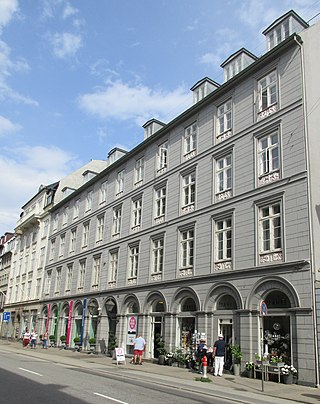
The Grandjean House is a Late Neoclassical property consisting of two separate buildings, one at Bredgade 4 and one at Store Strandstræde 3, on opposite sides of a central courtyard, in central Copenhagen, Denmark. The property is separated from Kongens Nytorv by a small building that now houses Copenhagen Amber Museum. It was built in 1854 by the architect Christian Tybjerg for pastry chef Christian Bredo Grandjean. It replaced an older building, which was known as the Collin House after Hans Christian Andersen patron Jonas Collin, but this name is now associated with another building in Amaliegade. The Grandjean House was listed on the Danish registry of protected buildings and places in 1959.

The De Coninck House is a historic property located at Store Kongensgade 72 in central Copenhagen, Denmark. It takes its name after Frédéric de Coninck for whom it was built in the 1790s.
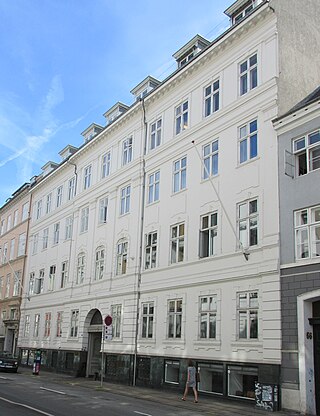
The Danneskiold-Laurvig Mansion is a historic building situated at Store Kongensgade 68 in central Copenhagen, Denmark. It was built in association with the Moltke's Mansion in Bredgade on the other side of the block.
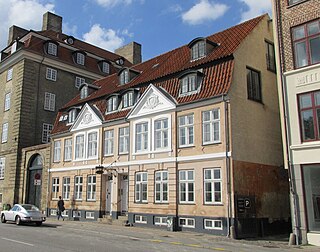
The Holmblad House, now also known as Sølvgården, is a former 18th-century dyeing facility at Sølvgade 38 in Copenhagen, Denmark. Its founder, Jacob Holmblad, also had his home in the complex. The building was listed by the Danish Heritage Agency in the Danish national registry of protected buildings in 1918.

Oremandsgaard is a manor house and estate located seven kilometres south of Præstø, Vordingborg Municipality, in southeastern Denmark. The estate traces its history back to the 14th century, but the current main building is from 1933. Oremandsgaard was acquired by Alfred Hage in 1861 and is currently owned by the fifth generation of the Hage family. It is one of the oldest organic farms in Denmark and plays host to an annual chamber music festival.
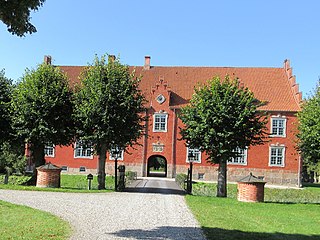
Aastrup is a manor house and estate in Elverdamsdalen, between Tølløse and Hvalsø, Lejre Municipality, some 40 kilometres west of Copenhagen, Denmark.
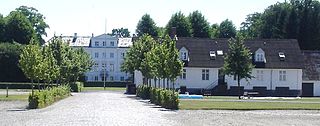
Lilliendal is a manor house and estate located at Vordingborg in southeastern Denmark. The estate covers approximately 800 hectares of mostly farmland. Lilliendal was established by Hans Gustav Lillienskiold (1727–1796) in the 1760s and later owned by the Knuth family for almost two hundred years from the 1800s to 1994. A relatively small main building from 1765 was expanded in the 1850s and again in 1919.

Niels Lunde Reiersen was a Danish government official, merchant, silk manufacturer, landowner and philanthropist. He was the owner of the Royal Danish Silk Manufactury in Copenhagen (1775-1796) as well as a founding partner of the leading trading firm De Coninck & Reiersen (1775-1790). Reiersen owned Nysø Manor, Oremandsgaard Manor and Lilliendal Manor as well as the estates at Jungshoved and Høfdinggård on Southern Zealand.

Falkensteen is a manor house located five kilometres south of Slagelse, Denmark. The current Neoclassical main building was built for Georg Frederik Ditlev Koës in 1775. It was listed on the Danish registry of protected buildings and places in 1950. A half-timbered barn from 1864 is also listed.

Kronprinsessegade 26 is a Neoclassical property overlooking Rosenborg Castle Garden in central Copenhagen, Denmark. The building was listed on the Danish registry of protected buildings and places in 1932.

Jean de Coninck (1744–1807) was a Dutch-Danish merchant and ship-owner. In 1785, he joined his elder brother, Frédéric de Coninck, as partner in the Copenhagen-based trading house Coninck & Reiersen. He purchased the country house Marienborg in 1803 and was from 1806 a co-owner of the Royal Danish Silk Manufactury in Bredgade. He served as Russian consul in Copenhagen.

Bredgade 38 is a Neoclassical property in the Frederiksstaden neighborhood of central Copenhagen, Denmark. The building was listed in the Danish registry of protected buildings and places in 1951. Notable former residents include the naval officer Carl Wilhelm Jessen and businessman Emil Vett.

John Christmas was an English-born Danish sea captain and merchant. Christmas was born in Bideford, and emigrated to Denmark in 1790. He became a merchant and business owner in Copenhagen. He was the father of naval officer and plantation owner on Saint Croix in the Danish West Indies, John Christmas.

Store Kongensgade 81 is a Neoclassical property situated in Store Kongensgade between Frederiksgade and Hindegade, in Copenhagen, Denmark. The complex consists of a Neoclassical residential building from the 1780s fronting the street and a number of somewhat older secondary wings, surrounding two consecutive courtyards, on its rear. It was listed in the Danish registry of protected buildings and places in 1918. The artist Lorenz Frølich, whose father and uncle owned the property for almost 50 years, spent his childhood at the site. Other notable former residents include former Governor-General of the Danish West Indies Frederik von Walterstorff, historian and social critic Niels Ditlev Riegels, physician Johan Daniel Herholdt (1764-1836) and painter August Schiøtt. The property is now owned by Jeudan.
Daniel Gottvald Reimer Bentley was a Danish civil servant. He served as mayor of Copenhagen from 1822 to 1857.

Bredgade 45 is a former town mansion situated around the corner from Frederik's Church in the Frederiksstaden district of central Copenhagen, Denmark. Originally constructed as an extension to the adjacent Moltke Mansion, it owes its current Historicist design to a renovation undertaken by Vilhelm Dahlerup. Notable residents include Governor-General of the Danish West Indies Peter von Scholten, naval officer Steen Andersen Bille, landowner Peder Brønnum Scavenius and businessman and art collector Heinrich Hirschsprung. The property is now owned by Jeudan. Female Founders House, a hub for femakle entrepreneurs, is based in the side wing.























